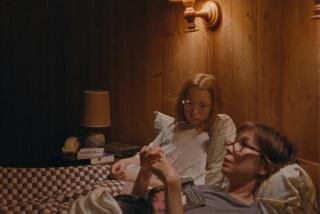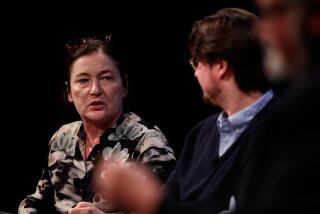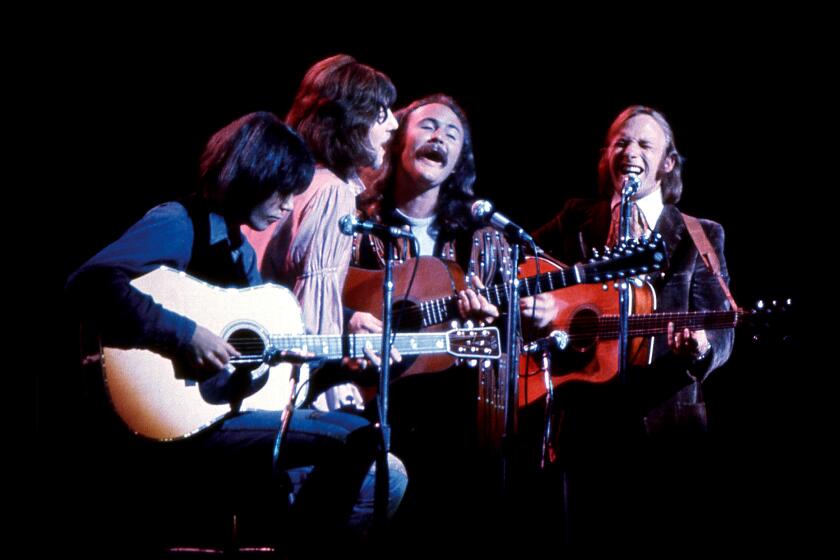Baker exhibit aptly shines with stardust
- Share via
WASHINGTON — She was limber, and she was wicked. She had the gift of looking just this side of muscular, and yet quite feminine. Dancing onstage, she could be a blur. It’s as if there were mercury in her shoulders, something that could lift her up and spin her around.
Her act was a taunt and a tease. It also was a celebration of herself. She knew sex, and she knew the lighted and unlighted dreams of men. And she played with those dreams as the lioness does the fawn.
The clean light of Paris loved Josephine Baker, and in the 1920s she turned that metropolis into her own revolving feast. The powerful and sometimes haunting imagery from her Paris days (and much more) dominates a new exhibition of drawings, prints, posters, photos and memorabilia at the National Portrait Gallery. Showing through March 18, “Josephine Baker: Image and Icon” is aptly titled.
She seemed all her life such a startling creation, an invented soul who lived better by the year. Her imagery proved too powerful to ignore, and in the end, America, blacks and whites -- she could jangle the emotions of both -- had to give her respect, give her honor.
The exhibition tracks her life in ways intimate and giddily resonant of her stardust.
Born in St. Louis in 1906, young Josephine took to the vaudeville road in her teens. She rolled the coin in America as far as it would go: nightclubs, vaudeville, Broadway. A black woman -- and reminded of it daily -- she sailed for Europe before the coin fell to the curb, taking her with it. In Europe, the coin was off the curb and gleaming like a diamond. She smiled with such raw and infectious joy.
In Paris, as the cabaret seasons passed and the summers came and went, she kept dazzling. She sang, she laughed, she clowned. Home was an ocean away. On winter evenings an expatriate, even in a crowd, can feel lonely. Sometimes she cried.
French artists drew her, photographers snapped her. The lithographs were colorful and bawdy. Politicians gaped at her on the stage and wondered about her America. She forced literary lions to write about her.
The poet e.e. cummings said of her: “She enters through a dense electric twilight, walking backwards on hands and feet, legs and arms stiff, down a huge jungle tree as a creature neither infrahuman nor superhuman but somehow both: a mysteriously unkillable Something, equally non-primitive and uncivilized, or beyond time in the sense that emotion is beyond arithmetic.”
During World War II, she took part in the Resistance, spying on the Germans.
In 1961, she was awarded the French Legion of Honor for her wartime service. Two years later, she showed up at the March on Washington. It was hot on the Mall. Still, she wore her Free French uniform and her Legion medal. She strode proudly right beside the Mississippi sharecroppers. She looked approachable -- and regal. Sammy Davis Jr.’s jaw dropped at the sight of her; he gave her a lift in his limo afterward.
Baker died in 1975, and then -- with many beginning to study and ponder her life -- she began to grow like a monument.
This exhibition -- originally organized by the Sheldon Art Galleries in St. Louis -- adds to the iconography. Curators have culled materials from the Metropolitan Museum of Art, the Schomburg Center for Research in Black Culture, the National Portrait Gallery itself, as well as private collections throughout Europe and America.
Backstage at the Casino de Paris in 1930, she’s wearing that art deco hairstyle and a silvery dance outfit. Her legs, bent with feet resting on another chair, rise like torpedoes. Her eyes are a riot of openness. She must be readying to pounce onto the stage.
She could look androgynous, especially as captured in a 1925 Baron Adolf de Meyer portrait. It’s a gelatin silver print. She wears a light-colored jacket that looks mannish. She looks so young; she had been in Paris only a few years.
Black American artists, buoyed by the reception of black soldiers who had fought in World War I and been welcomed in France, started arriving in Paris during the 1920s. Baker often credited them with making her entree into French society easier. Jazzman Sidney Bechet was there; the cabaret figure Bricktop was there. In time many other blacks came: Langston Hughes, Eartha Kitt, James Baldwin, Claude McKay, Countee Cullen. Some stayed, some passed through.
The French came to be quite curious about black life. The expression le tumulte noir was often heard. (It refers to a fascination with black culture and life.)
You can move from room to room throughout the exhibit and gaze in astonishment at the grandness of a life, the global swing of a life Baker possessed. In 1951, onstage in Havana, in a strapless gown with trumpet skirt and train, she looks like Queen Nefertiti.
There are cabaret and nightclub programs in the exhibit, done colorfully in lipstick red with Baker drawn on the cover. The French take production of their cabaret programs seriously. The things are gorgeous.
Baker seems to have burst upon the scene a diva’s diva.
Her stage act was fast; some called it savage. Sometimes she danced topless. (Those early Parisian appearances in blackface would seem to come to haunt her, as they would many a black American performer.)
“Driven by dark forces I didn’t recognize,” she once sought to explain of her style, “I improvised, crazed by the music, the overheated theater filled to the bursting point, the scorching eye of the spotlights. Even my teeth and eyes burned with fever. Each time I leaped I seemed to touch the sky, and when I regained earth it seemed to be mine alone.”
She had lovers and husbands. She was never, however, able to have children of her own, though she would compensate by adopting a dozen.
Her relationship with America was complex.
In the 1930s, she returned to the U.S. for an engagement with the Ziegfeld Follies. She believed her fame in Paris would give her currency and acceptance. But she was told not to wear her dazzling Parisian gowns and given second billing to Fanny Brice.
Baker shook her head and scooted back across the ocean.
More to Read
The biggest entertainment stories
Get our big stories about Hollywood, film, television, music, arts, culture and more right in your inbox as soon as they publish.
You may occasionally receive promotional content from the Los Angeles Times.










